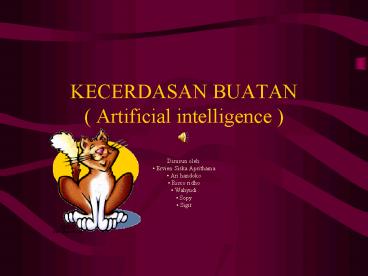KECERDASAN BUATAN Artificial intelligence - PowerPoint PPT Presentation
1 / 23
Title:
KECERDASAN BUATAN Artificial intelligence
Description:
Intelligent connection of perception and action ... Smart clothes ... than on knowledge of the environment that has been built-in by the designer ... – PowerPoint PPT presentation
Number of Views:968
Avg rating:3.0/5.0
Title: KECERDASAN BUATAN Artificial intelligence
1
KECERDASAN BUATAN( Artificial intelligence )
- Disusun oleh
- Ervien Siska Aprithama
- Ari handoko
- Risco ridho
- Wahyudi
- Sopy
- Sigit
2
What is AI?
- A science of making intelligent machines
- A study to make computer systems to have
intelligence
3
Goals of AI
- Replicate human intelligence
- Solve knowledge-intensive tasks
- Intelligent connection of perception and action
- Enhance human-human, human-computer and
computer-computer interaction /communication
4
Some Application Areas of AI
- Game Playing
- Speech Recognition
- Computer Vision
- Expert Systems
- Diagnostic Systems
- System Configuration
- Financial Decision Making
- Classification Systems
5
Some Application Areas of AI
- Mathematical Theorem Proving
- Natural Language Understanding
- Scheduling and Planning
6
Some AI "Grand Challenge Problems
- Translating telephone
- Accident-avoiding car
- Aids for the disabled
- Smart clothes
- Intelligent agents that monitor and manage
information by filtering, digesting, abstracting - Tutors
- Self-organizing systems, e.g., that learn to
assemble something by observing a human do it.
7
A Framework for Building AI Systems
- Perception
- Reasoning
- Action
8
Some Fundamental Issues for Most AI Problems
- Representation
- Search
- Inference
- Learning
- Planning
9
Design Methodology and Goals
- Engineering Goal
- Science Goal
- Alternatives methodology
- Think like humans"cognitive science, Ex. GPS 2
- Think rationally, formalize inference process
"laws of thought" - Act like humans Ex. ELIZA, Turing Test 4
- Act rationally "satisficing" methods
10
Symbols versus Signals
- Physical-Symbol System information processing
model
11
Intelligent Agents
- What is an Intelligent Agent?
- Agent Characteristics
- Situatedness
- Autonomy
- Adaptivity
- Sociability
12
sensor
percepts
environment
agent
actions
effectors
13
Examples of Agents
14
A Skeleton Agent
function SKELETON-AGENT(percept) returns
action static memory, the agents memory of the
world memory UPDATE-MEMORY(memory,percep
t) action CHOOSE-BEST-ACTION(memory) m
emory UPDATE-MEMORY(memory,action) retur
n action
15
How to Evaluate an Agent's Behavior/Performance?
- Rationality
- the percept sequence
- its built-in and acquired knowledge
- Types of objective performance measures
- false alarm rate
- false dismissal rate
- time taken
- resources required
- effect on environment, etc.
16
Approaches to Agent Design
- Simple Reflex Agent
- Table lookup of percept-action pairs defining all
possible condition-action rules necessary to
interact in an environment - Problems
- Too big to generate and to store (Chess has about
10120 states, for example) - No knowledge of non-perceptual parts of the
current state - Not adaptive to changes in the environment
requires entire table to be updated if changes
occur - Looping Can't make actions conditional
17
- Reflex Agent with Internal State
- Encode "internal state" of the world
- Needed because sensors do not usually give the
entire state of the world - Requires ability to represent change in the world
- Example Rodney Brooks's Subsumption Architecture
- Goal-Based Agent
- Choose actions so as to achieve a goal
- Need to add goals to decide which situations are
good - Deliberative instead of reactive
- Involves consideration of the future
18
- Utility-Based Agent
- How to decide which one is best?
- A goal specifies a crude distinction between a
happy and unhappy state - Utility function U State -- Realsindicating a
measure of success or happiness when at a given
state - Allows decisions comparing choice between
conflicting goals, and choice between likelihood
of success and importance of goal (if achievement
is uncertain)
19
Properties of Environment
- Accessible vs. inaccessible
- Deterministic vs. nondeterministic
- Episodic vs. nonepisodic
- Static vs. dynamic
- Descrete vs. continuous
20
Summary Chap.2
- An agent is something that perceives and acts in
an environment - An ideal agent is one that always takes the
action that is expected to maximize its
performance measure, given the percept sequence
it has seen so far - An agent is autonomous to the extent that its
action choices depend on its own experience,
rather than on knowledge of the environment that
has been built-in by the designer - An agent program maps from percept to an action,
while updating internal state - There exists a variety of basic agent program
designs, depending on the kind of information
made explicit and used in the decision process - Reflex agents respond immediately to percepts,
goal-based agents act so that they will achieve
their goals, and utility-based agents try to
maximize their own happiness - The process of making decisions by reasoning with
knowledge is central to AI and to successful
agent design - Some environments are more demanding than others
21
PERNAHKAH anda membayangkan dapat berbicara
dengan seseorang yang telah meninggal 5 tahun
lalu? Jangan keburu membayangkan bahwa anda harus
mendatangi seorang arwah.
Care-O-bot II, robot pembantu bagi penyandang
cacat
22
(No Transcript)
23
(No Transcript)































